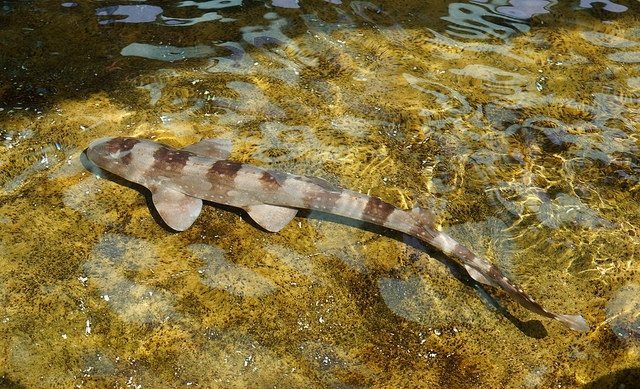Bamboo sharks shrug their 'shoulders' to swallow their prey
Sharks don't have tongues to move food through their mouths, so instead they swinging their girdle.
A sophisticated X-ray technology has allowed US scientists to study how bamboo sharks feed themselves by moving their "shoulders."
Unlike other species, sharks don't possess tongues. But their long pharynx mean they still have to suck their food all the way down, from catching prey to actually swallowing them.
Lead author Ariel Camp, post-doctoral student from Brown University, says: "Sharks and fishes that don't have a tongue control the motion of fluid within their mouths to manipulate food."
In order to do so, bamboo sharks retract their vertebrate pectoral girdle, the part of the skeleton that supports the upper extremities, which lies between the head, neck, forelimbs and thorax, in order to provide sufficient suction. In simple terms, it means they are literally "shrugging" when they eat.
The sharks' girdle is described as: "a single rigid element covered entirely by muscles and skin," and its movements are difficult to spot in external videos.
Because it is completely separated from the skull, scientists assumed it remained still when sharks ate. They only studied the girdle in regards to the sharks movements.
Camp and her colleagues used a technology developed at Brown called X-ray Reconstruction of Moving Morphology (XROMM). It involves using 3D digital models as well as high speed X-ray videos to create "accurate and precise animations" of moving shark skeletons from within, thus allowing researchers to take a closer look at "deep structures" like the girdle.
The team tested the rays on three sharks in order to study the dynamics of their feeding.
Thanks to the XROMM, they discovered that when they ate, the sharks' shoulder girdles were far from still. Instead, they'd swing, rotating backwards from head to tail by about 11 degrees.
What the girdle means for evolution
The study only focused on bamboo sharks, but Camp suspects their morphology is similar to other shark species, which means several types could potentially move their girdles in the same way. Many sharks could have been shrugging all along, unbeknown to scientists. However, further studies are needed to confirm this hypothesis.

Camp also thinks the girdle may shed light on different aspects of the evolution of sharks. Understanding how their "skeletal structures" evolved would help explain how some creatures eventually became capable of making it to land.
"We aren't sure exactly what structures it evolved from or how that happened," said Camp. "Part of understanding that history is understanding what were the functions this structure had to carry out."
Thanks to Ariel Camp and her colleagues, we now know it was eating, as well as moving. The complete findings are published in the Royal Proceedings of the Society B.
© Copyright IBTimes 2025. All rights reserved.






















